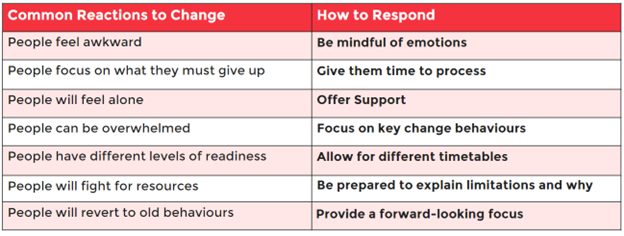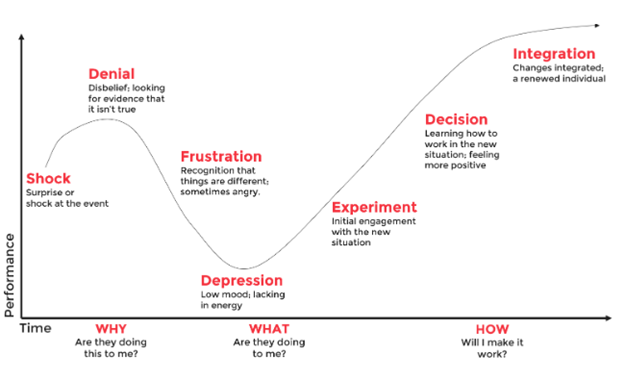We sometimes assume if we build it, they will come. Then we encounter unexpected resistance to our change projects. By understanding the psychology of change, we can better deal with resistance and make change happen with less friction.
This article is part of our Change Management series. For more information about this series visit our Change Resources page.
The Psychology of Change
Humans have a love-hate relationship with change. Do people like change? As with many things in life, the answer is “it depends.”
Employees often resist change. As leaders we must know how to recognize the emotions when they occur.

The good news is that people usually experience these emotions in a sequence. This is known as the Kubler-Ross change model, or what we like to call the Change Valley. This model helps us to plot where we and others are in the process of change, why we feel what we feel, and what to do next. Almost all change follows this pattern, though the time spent in each phase and the depth of the “valley”, can differ greatly.
Barb Reppert provides insight to the Psychology of Change
The Change Valley

To better illustrate how this model works, let’s take the example of learning to drive a car. Before the change stimuli (the shock), the status quo is using other modes of transportation. This could include friends, family, public or private transportation systems.
Then the stimulus arrives either as a proactive decision (I want to learn to drive) or a reaction to something externally (my parents want me to drive). That trigger moves us into the valley as we begin the journey.
In the early days it’s very uncertain, even frightening, as we get behind the steering wheel for the first time. We try, we fail, we experiment, we practice. We make mistakes and hopefully we keep trying. In these phases we can feel frustrated and even depressed.
Then slowly, sometimes very slowly, we begin to climb back out of the valley as we grow in confidence, skill, and certainty. Ultimately, we reach the far side of the valley, the integration, with greater skill.
“People don’t resist change. They resist being changed!”
- Peter Senge, author of The Fifth Discipline
In some cases, people are unsuccessful in crossing the valley. This can happen for many reasons; maybe the journey is too long or hard, or the valley too deep for an individual’s fortitude. Maybe circumstances change such that the goal is no longer attractive or worthwhile. Or possibly the expected resources or support for the change don’t show up. In these situations, a person might climb back to the starting point, returning to the original status quo.
The example provided above is not just a journey of change, but also a journey of learning; the two always go hand in hand. To deal with or capitalize on change, we must learn new skills and behaviours. And by increasing our skills and learning new behaviours, we are better equipped to cope with change in our businesses and lives. Learning and change are inseparable.
In our work here at Results we are very blessed to interact with the people in our society who are very skilled in the change-learning equation. These are the entrepreneurs in our communities. We like to call them the “Change Sherpas”, those people who are rarely satisfied with the status quo and who seem to be constantly looking for the next change valley to dive into (and yes, they often drive their employees and families crazy).
Don’t underestimate the importance of the Change Sherpas. A glance at our nation’s economic statistics will show that net employment growth for the past 25 years does not come from big companies or the public sector.
It comes from small and medium sized entrepreneurial companies. It comes from companies whose leaders are highly skilled at managing resistance to change in an organization. These firms, and their leaders, drive the economic engine of the world.
Overcome Resistance to Change in an Organization
Understanding and using the Change Valley is a valuable tool for leaders. Leaders play a crucial role in change by guiding and initiating it. They can support their team by helping them recognize their position in the model, acknowledging their emotions, and assisting them in progressing to the next stage. These leaders are the Change Sherpas for their teams who are traveling through the Valley. They provide encouragement, support, training, advice, and regular reminders of how great the view will be from the other side.
If you’d like to learn more about change or other ways you can take the simpler path to creating a great business, connect with us or consider attending one of our upcoming leadership events.




